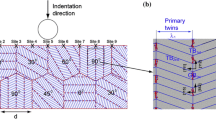Abstract
A theoretical model of microscopic mechanisms of the nucleation and development of deformation twins in nanocrystalline materials has been developed. Within the model, we have studied the generation of deformation twins near crack tips, which occurs through multiple nanoscopic shears that represent nanoscopic regions of an ideal plastic shear. It has been shown that the nucleation of such nanotwins near crack tips reduces the high local stresses that arise near these tips. Thus, the generation and development of nanotwins near crack tips increases the fracture toughness of brittle nanocrystalline materials and serves as an efficient mechanism of improving the crack resistance of deformed nanocrystalline materials.
Similar content being viewed by others
References
A. Aronin, G. Abrosimova, D. Matveev, and O. Rybchenko, Rev. Adv. Mater. Sci. 25(1), 52 (2010).
N. F. Morozov, Mathematical Problems of the Theory of Cracks (Nauka, Moscow, 1984) [in Russian].
A. S. Khan, Y. S. Suh, X. Chen, L. Takacs, and H. Zhang, Int. J. Plasticity 22, 195 (2006).
G.-D. Zhan and A. K. Mukherjee, Rev. Adv. Mater. Sci. 10(3), 185 (2005).
N. F. Morozov, I. A. Ovid’ko, A. G. Sheinerman, and E. C. Aifantis, Fiz. Mekh. Mater. 8(2) (2009).
V. L. Likhachov, A. I. Vergazov, V. V. Rybin, and Yu. V. Solomko, Fiz. Met. Metalloved. 43(1), 70 (1977).
V. V. Rybin, TRANSL (Metallurgiya, Moscow, 1986) [in Russian].
S. V. Bobylev, A. K. Mukherjee, I. A. Ovid’ko, and A. G. Sheinerman, Int. J. Plasticity 26(11), 1629 (2010).
Y. T. Zhu, X. Z. Liao, and X. L. Wu, Prog. Mater. Sci. 57(1), 1 (2012).
Y. T. Zhu, X. L. Wu, X. Z. Liao, J. Narayan, S. N. Matha- udhu, and L. J. Kecskes, Appl. Phys. Lett. 95, 031909 (2009).
I. A. Ovid’ko and A. G. Sheinerman, Rev. Adv. Mater. Sci. 27(2), 189 (2011).
N. F. Morozov, I. A. Ovid’ko, A. G. Sheinerman, and N. V. Skiba, Rev. Adv. Mater. Sci. 32(1), 75 (2012).
J. P. Hirth and J. Lothe, Theory of Dislocations (Wiley, New York, 1982; Atomizdat, Moscow, 1972).
Mechanics of Fracture and Strength of Materials, Ed. by V. V. Panasyuk (Naukova Dumka, Kiev, 1988) [in Russian].
N. F. Morozov, I. A. Ovid’ko, A. G. Sheinerman, and E. C. Aifantis, J. Mech. Phys. Solids 58, 1088 (2010).
Author information
Authors and Affiliations
Additional information
Original Russian Text © N.F. Morozov, I.A. Ovid’ko, N.V. Skiba, A.G. Sheinerman, 2013, published in Doklady Akademii Nauk, 2013, Vol. 453, No. 6, pp. 630–633.
Rights and permissions
About this article
Cite this article
Morozov, N.F., Ovid’ko, I.A., Skiba, N.V. et al. Influence of nanotwin generation near crack twins on the fracture toughness of nanomaterials. Dokl. Phys. 58, 544–547 (2013). https://doi.org/10.1134/S1028335813120082
Received:
Published:
Issue Date:
DOI: https://doi.org/10.1134/S1028335813120082



